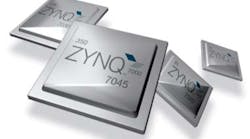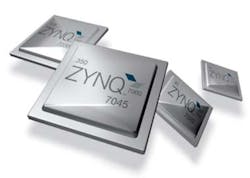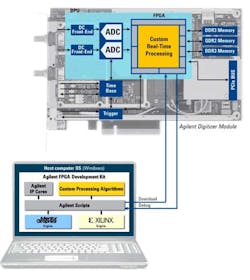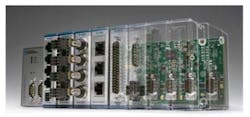Vendors Leverage FPGAs, SoCs to Speed Test
The growing speed, density, and complexity of today’s semiconductors are presenting significant test challenges to those testing the devices or products in which they are used. Fortunately, test vendors including Agilent Technologies, Marvin Test Systems, and National Instruments can leverage advanced semiconductor technology to keep pace with expanding needs for high-speed automated test. They are integrating high-performance processors, FPGAs, and SoCs into their instruments and providing their customers with programmable access to the devices.
In addition, Xilinx has combined processing and FPGA technology within its Zynq family of all-programmable SoCs (Figure 1), and National Instruments is using Zynq’s capabilities to extend advanced processor and FPGA technology beyond ATE and into embedded-system control and monitoring.
Courtesy of Xylinx
Speaking at NIWeek in August, Eric Starkloff, senior vice president of marketing at NI, said that as the world becomes more programmable, the devices we have to test become more complex. “Creating high-performance automated test systems has long been a core application of NI’s platform,” he said. “We’ve built on Moore’s law to drastically reduce the cost of test by leveraging the performance improvements of the underlying technology and delivering continuity over time through the software.” He added that the FPGA, in particular, promises an even greater performance increase in test systems and that NI has incorporated the technology into test systems through the NI LabVIEW RIO architecture.
Starkloff cited as an example of an FPGA-based instrument the company’s NI PXIe-5644R vector signal transceiver (VST) introduced at NIWeek 2012. The VST, which is an example of what NI calls software-designed instrumentation, incorporates a software-centric architecture that lets engineers and scientists use LabVIEW to tailor open, FPGA-based hardware for their specific needs. In February, the company introduced a second VST, which adds a differential or single-ended I/Q interface to support test of both the RF and baseband signals.
“The VST,” Starkloff said, “has been one of the most successful products that NI has ever launched, both in terms of sales volume and in the diversity of applications that it has been able to address—everything from next-generation communications research to high-volume production test of wireless devices, and we see a tremendous opportunity to build on that success to solve even more applications.”
Recent FPGA-related innovations from NI include new instrument-driver FPGA extensions, a feature of the NI RF signal analyzer and RF signal generator instrument drivers that combines the flexibility of the open FPGA with the compatibility engineers expect from an industry-standard instrument driver. FPGA extensions build on the release of the VST to make it easier for those with little to no FPGA programming experience to access the benefits of an open FPGA to better meet application demands with additional processing and control.
Engineers already using VSTs can upgrade their drivers, then mix application-specific FPGA code with standard instrument driver code.
Starkloff said engineers at Hittite Microwave have used instrument driver FPGA extensions to take advantage of the existing RF and baseband I/Q analysis and generation capabilities of the VST while modifying the user-programmable FPGA to implement custom signal-processing and digital DUT control. Presenters at NIWeek demonstrated a Hittite test application, showing significant improvements in test speed. The application is described in detail in a case study.1
Digital I/O Cards
Marvin Test Solutions got an early start in providing its customers with access to instrument-embedded FPGAs when the company (then named Geotest-Marvin Test Systems) introduced its GX3700 and GX3700e digital I/O cards at Autotestcon 2011.2 The PXI GX3700 and PXIe GX3700e include user-configurable, onboard Altera Stratix III FPGAs. The module software is fully compatible with Altera object files. No proprietary FPGA design tools are required, and the modules are compatible with Altera’s free, web-based Quartus II design tools.
The GX3700e offers 160 digital I/O signals available for user-specific applications. A x4 PXI Express interface and integral DMA controller support data-streaming rates of more than 800 MB/s. It features a 700-MHz digital I/O clock rate and includes 8 MB of onboard SSRAM.
Other PXI instruments from Marvin Test Solutions with user-programmable FPGAs include the GX3500 150-MHz FLEX digital I/O FPGA card, the GX3601 80-channel TTL buffer card, the GX3609 80-TTL differential-channel card, the GX3610 80-channel mLVDS buffer card, and the GX3640 40-channel ECL buffer card.
In a recent email conversation, Mike Dewey, senior product marketing manager, commented on the GX3700e. “The card is designed so that it is easy for customers to do their own designs,” he said. “Using Altera tools, customers can design using schematic entry or VHDL—the former is used if the designs are not complex or the user is not familiar with VHDL. The design of the card was done so that users do not have to incorporate the PCI infrastructure into their specific design (we have a separate FPGA for that), which makes the FPGA user design less complex.
“We will help out with the programming if necessary,” he added, “but generally, customers end up doing their own design work. Our user guide has examples to help customers get started doing their own designs. We do see test engineers recruiting support from their design engineering department if the FPGA design is complex.”
FPGA Development Kit
Agilent also offers its customers FPGA programmability though its U5340A FPGA development kit (Figure 2), introduced in June, which allows users to deploy advanced real-time signal processing into the FPGAs onboard Agilent high-speed digitizers. The kit enables original equipment manufacturers and researchers to design-in high-speed signal-acquisition and analysis. This software tool can help companies and research institutions protect their intellectual property and shorten time-to-market as they develop technologies for high-end applications such as medical imaging, environmental monitoring, time-of-flight spectroscopy, and radar.
Courtesy of Agilent Technologies
The kit is powered by a custom Mentor Graphics design engine, which features Mentor’s HDL Author, ModelSim PE, and Precision Synthesis tools. The Mentor engine is embedded in the Agilent kit to support the design, synthesis, simulation, and validation of signal-processing algorithms. Place-and-route and bitfile-generation engines are included as well as debugging capabilities.
To help users focus on creating solutions, the FPGA development kit also includes a library of building blocks, from basic gates to dual-port RAM memories; a set of IP cores; and ready-to-use scripts that handle all aspects of the automated build flow. A full-speed design example and companion software ensure efficient system integration.
Presynthesized and area-constrained IP cores—based on the AMBA AXI4 standard—accelerate implementation and ensure repeatable results. The FPGA development kit also embeds complete calibration capabilities to ensure the analog performance of Agilent digitizers when used with end-user firmware.
The first release of the U5340A FPGA development kit is available for the Agilent U5303A PCIe 12-bit high-speed digitizer with onboard processing, also introduced in June, and the kit will be available for future products. The U5303A is a compact dual-channel PCIe digitizer with 12-bit resolution, sampling up to 3.2 GS/s, and onboard real-time processing. It delivers high analog fidelity, high effective number of bits, and very low noise. The digitizer offers DC to 1.8-GHz bandwidth, 9.1-ENOB at 100 MHz, a 58-dB signal-to-noise ratio, and high data transfer rates from an eight-lane PCIe 2.0 interface. The U5303A can be used in systems in commercial, industrial, aerospace, and defense applications. Uses include medical imaging, environmental monitoring, analytical time-of-flight, ultrasonic nondestructive testing, and radar. It incorporates a Xilinx Virtex-6 FPGA.
FPGAs with Processors
An FPGA alone can provide a significant boost to instrument performance. So, too, can a high-performance processor. As an example, in June ADLINK Technology introduced its PXI-3980 quad-core PXI embedded controller featuring the high-performance Intel Core i7-2715QE 2.1-GHz processor, with up to 16 GB of 1,333-MHz DDR3 memory, for seamless execution in multitasking environments and reduced test times. The PXI-3980 features dual BIOS backup to reduce maintenance costs, multiple interfaces for connecting and controlling a variety of standalone instruments, user-friendly access design for easy maintenance, and support for hybrid PXI-based testing system control.
Of course, leveraging advanced processor and FPGA technology in a single device can yield even more benefits. Speaking at NIWeek, Victor Peng, senior vice president of the programmable platforms group at Xilinx, described his company’s 7 Series FPGAs as based on a state-of-the-art 28-nm process—the smaller geometry allowing the company to lower power consumption while increasing logic density, processing performance, and I/O bandwidth.
But combining FPGA and processor technology within one device can offer additional advantages. To that end, Xilinx has introduces its Zynq family of all-programmable SoCs. Peng described the Zynq as “a whole new product family” that integrates a powerful ARM Cortex A9 processor subsystem together with Xilinx’s 7 Series FPGA fabric. He described NI as one of Xilinx’s preeminent lighthouse customers that provided invaluable feedback regarding Zynq.
Also speaking at NIWeek, Tom Lantzsch, executive vice president for strategy at ARM, commented on the use of his firm’s technology within Zynq. “Most people think about ARM and our processing technology powering mobile revolution,” he said. “Last year, the ARM partnership shipped about 9 billion chips into the marketplace. But what most people probably don’t know is that a little over 2 billion of those devices went into the embedded-processing area. And actually that’s our fastest growing market today.” He added that over the past several years the ARM partnership has spend a lot of time ensuring that the processor cores provide high reliability at high temperatures and meet the low-power requirements to serve the next generation of intelligent systems.
The Cortex A9, Lantzsch said, has been licensed to about 60 customers worldwide and finds use in servers, consumer devices, automobiles, and other applications. Peng added that Xilinx is addressing automated driver-assist systems, situational-awareness systems in aerospace and defense applications, and broadcast cameras with real-time processing and analytics.
However, said Lantzsch, addressing NIWeek attendees, “I think what’s really exciting to this audience is the combination of this technology plus [NI’s] software tools and LabVIEW programming models. That really opens up heterogeneous compute technology to a much broader group of engineers that doesn’t need to understand CPU technology and can program using their domain expertise.”
NI has wasted little time in applying the technology combination. Starkloff introduced the cRIO-9068 software-designed controller (Figure 3), that he said is completely redesigned but maintains full NI LabVIEW and I/O compatibility with the CompactRIO platform, which integrates the Xilinx Zynq-7020 all-programmable SoC. The cRIO-960 offers four times faster performance than previous cRIO generations. Robert Bielby, senior director of strategic marketing and business planning at Xilinx, elaborated on Zynq and the cRIO controller in a white paper.3
Courtesy of National Instruments
Applications
Speaking at NIWeek, Bob Leigh, president and CEO of LocalGrid Technologies, said, “Within 24 hours of receiving a cRIO-9068 controller, we ran our existing LabVIEW application software without any problems. We were impressed by the easy software transition between CompactRIO systems and by the incredible performance improvement of the new software-designed controller.”
LocalGrid uses the system to enable seamless, secure high-resolution analytics and control of distributed generation resources and grid assets to monitor feeder networks, dispatch generation, optimize distribution assets, or manage a microgrid network.
Addressing Peng and Lantzsch at NIWeek, Starkloff concluded, “I think that [our organizations] are very complementary—we provide a platform that gives domain experts the ability to use the great technology you’ve created and to do so over a broad set of applications without necessarily having to know custom design.”
References
1. Hittite Microwave Reduces RF Integrated Circuit Test Cost and Improves Test Speed Using the NI PXI Vector Signal Transceiver and Instrument Driver FPGA Extensions, National Instruments, Case Study.
2. Nelson, R., “PXI Gets Boost at Autotestcon,” EE-Evaluation Engineering Online, October 2011.
3. Bielby, R., Introduction to the NI cRIO-9068 Controller Designed with the Xilinx Zynq-7000, National Instruments, White Paper.



